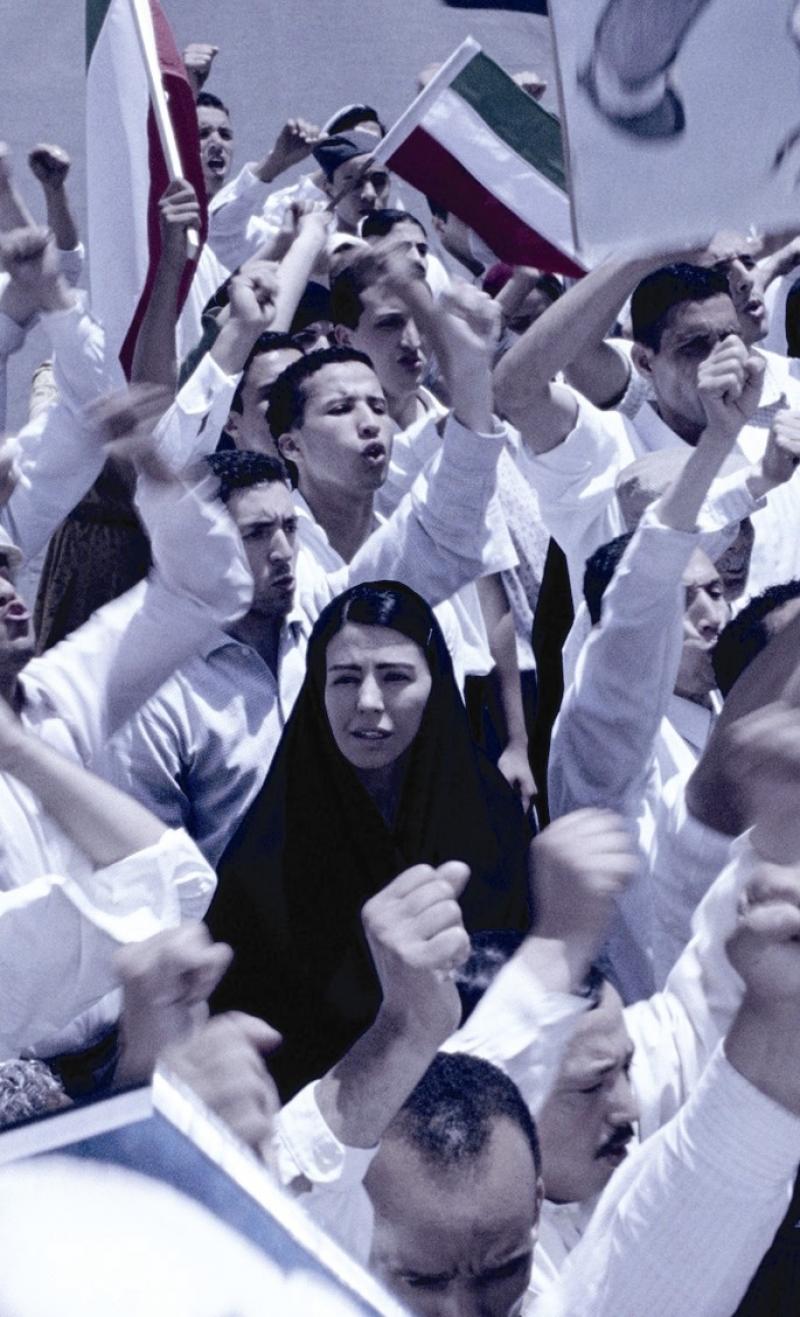Women Without Men | reviews, news & interviews
Women Without Men
Women Without Men
An often intoxicating film about 1950s Iranian women

Shirin Neshat's often compelling Women Without Men spirits us back to Tehran 1953, and the political atmosphere surrounding the British- and American-supported coup that deposed Iran’s first democratically elected prime minister, Mohammad Mossadegh.
“All that we wanted was to find a new form, a new way - release,” are the final lines we hear in Neshat’s film, spoken by one of her heroines as she jumps to her death. With its closing dedication to those who have lost their lives for freedom in Iran from the 1906 Constitutional Revolution through to last year’s Green Movement, Women Without Men is the story of the 1950s generation’s attempt to change their country, one that finally fails against Western interests that are defending access to Persian oil. Its implicit message is that the defeat of Mossadegh’s moderate reformist regime in 1953, and the restoration of an increasingly autocratic Shah, would in turn lead to the Islamic revolution a quarter of a century later.
Among the consequences of that later upheaval was Neshat’s own decision not to return to Iran from study abroad after 1979, and her subsequently establishing a reputation as a photographer and visual artist in the West. Her debut feature film takes as its source Shahrnush Parsipur’s 1989 novel of the same name, which saw its author twice imprisoned before she too left Iran in 1994. Further complicating the relationship between the director and her source is the fact that Neshat made five individual video projects, designed to be screened in a museum context, inspired by the novel’s main characters between 2004 and 2008.
 All the more reason then to concentrate on the film’s four main characters (one fell by the wayside in adaptation) in their own immediate context in the film. At one extreme of society is Fakhri (Arita Shahrzad), the wife of a general whose marriage has become restricting, but whose status gives her independence and the means to acquire the orchard (pictured right) and its house (visually it's not unlike a rather desirable holiday villa somewhere in southern Europe, complete with caretaker). At the opposite extreme there’s Zarin (played by the Hungarian actress Orsi Toth, whose refusal to speak itself speaks volumes), a prostitute repelled by her position who flees her old life for any refuge she can find, and spends much of the film in a kind of trance of withdrawal.
All the more reason then to concentrate on the film’s four main characters (one fell by the wayside in adaptation) in their own immediate context in the film. At one extreme of society is Fakhri (Arita Shahrzad), the wife of a general whose marriage has become restricting, but whose status gives her independence and the means to acquire the orchard (pictured right) and its house (visually it's not unlike a rather desirable holiday villa somewhere in southern Europe, complete with caretaker). At the opposite extreme there’s Zarin (played by the Hungarian actress Orsi Toth, whose refusal to speak itself speaks volumes), a prostitute repelled by her position who flees her old life for any refuge she can find, and spends much of the film in a kind of trance of withdrawal.
In between those two are Munis (Shabnam Toulouei), who’s glued to the radio and clearly absorbed by the political unrest, as well as unwilling to assume the role in society expected of her by her devout brother, and her friend Faezeh (Pegah Ferydoni), who’s far from revolutionary, and secretly in love with that same devout brother. They all live in a world where the choice to wear the veil or the latest foreign fashions is free, and where one of the most characteristic aspects of Persian society, at least in cosmopolitan Tehran, is its secular emphasis on integration of the sexes, particularly when there’s a party or cultural salon going on. (How hard that seems for us to imagine now, so ingrained have other images of Iran become over subsequent years - the same indeed is true of Afghanistan, if we look back, for instance, to episodes from the book and film The Kite Runner).
But with Munis dying in an early reel, and then coming back as a ghost to join the Communist activists who are trying to shape their own version of a future for their country, it’s clearly no straight story. The image of the garden, itself something of a trope in Persian literature, isn’t just a number on a street, either, but rather a fabulous mirage in the semi-desert, to which the main characters make their separate ways, as if driven by some exterior force; that doesn’t stop hostess Fakhri holding a final party there, itself disrupted by the arrival of the military in a further blurring of boundaries between the reality of urban unrest and mystic retreat. German cinematographer Martin Gschlocht relishes the full magical lusciousness of this private space in widescreen, while events unfolding in Tehran are shown with the colour consciously bled out of them (shooting locations were in Morocco, and stand in acceptably for Iran, while the main cast itself was drawn from the Iranian exile community).
But the overall effect is often strongest when such artistic flights of fancy are pared to a bare minimum, most particularly in Zarin’s story: she flees from the brothel where she has been confined to a local bath house in which, through sheer self-disgust, she scrubs her skeletal form until it bleeds, watched uneasily by the women around her. A restrained score from Japanese composer Ryuichi Sakamoto works most poignantly when it’s only just invading the silences. It's not that less is necessarily more - but that the combination of political reality and the escape into a magical world doesn't always hold together. It's a striking and intermittently glorious attempt, all the same.
Watch the Women Without Men trailer
The future of Arts Journalism
You can stop theartsdesk.com closing!
We urgently need financing to survive. Our fundraising drive has thus far raised £49,000 but we need to reach £100,000 or we will be forced to close. Please contribute here: https://gofund.me/c3f6033d
And if you can forward this information to anyone who might assist, we’d be grateful.

Subscribe to theartsdesk.com
Thank you for continuing to read our work on theartsdesk.com. For unlimited access to every article in its entirety, including our archive of more than 15,000 pieces, we're asking for £5 per month or £40 per year. We feel it's a very good deal, and hope you do too.
To take a subscription now simply click here.
And if you're looking for that extra gift for a friend or family member, why not treat them to a theartsdesk.com gift subscription?
more Film
 Iron Ladies review - working-class heroines of the Miners' Strike
Documentary salutes the staunch women who fought Thatcher's pit closures
Iron Ladies review - working-class heroines of the Miners' Strike
Documentary salutes the staunch women who fought Thatcher's pit closures
 Blu-ray: The Man in the White Suit
Ealing Studios' prescient black comedy, as sharp as ever
Blu-ray: The Man in the White Suit
Ealing Studios' prescient black comedy, as sharp as ever
 The Woman in Cabin 10 review - Scandi noir meets Agatha Christie on a superyacht
Reason goes overboard on a seagoing mystery thriller
The Woman in Cabin 10 review - Scandi noir meets Agatha Christie on a superyacht
Reason goes overboard on a seagoing mystery thriller
 London Film Festival 2025 - crime, punishment, pop stars and shrinks
Daniel Craig investigates, Jodie Foster speaks French and Colin Farrell has a gambling habit
London Film Festival 2025 - crime, punishment, pop stars and shrinks
Daniel Craig investigates, Jodie Foster speaks French and Colin Farrell has a gambling habit
 I Swear review - taking stock of Tourette's
A sharp and moving tale of cuss-words and tics
I Swear review - taking stock of Tourette's
A sharp and moving tale of cuss-words and tics
 A House of Dynamite review - the final countdown
Kathryn Bigelow's cautionary tale sets the nuclear clock ticking again
A House of Dynamite review - the final countdown
Kathryn Bigelow's cautionary tale sets the nuclear clock ticking again
 theartsdesk Q&A: Idris Elba on playing a US President faced with a missile crisis in 'A House of Dynamite'
The star talks about Presidential decision-making when millions of lives are imperilled
theartsdesk Q&A: Idris Elba on playing a US President faced with a missile crisis in 'A House of Dynamite'
The star talks about Presidential decision-making when millions of lives are imperilled
 Urchin review - superb homeless drama
Frank Dillane gives a star-making turn in Harris Dickinson’s impressive directorial debut
Urchin review - superb homeless drama
Frank Dillane gives a star-making turn in Harris Dickinson’s impressive directorial debut
 Mr Blake at Your Service review - John Malkovich in unlikely role as an English butler
Weird comedy directed by novelist Gilles Legardinier
Mr Blake at Your Service review - John Malkovich in unlikely role as an English butler
Weird comedy directed by novelist Gilles Legardinier
 Don't Let's Go to the Dogs Tonight review - vivid adaptation of a memoir about a Rhodesian childhood
Embeth Davidtz delivers an impressive directing debut and an exceptional child star
Don't Let's Go to the Dogs Tonight review - vivid adaptation of a memoir about a Rhodesian childhood
Embeth Davidtz delivers an impressive directing debut and an exceptional child star
 One Battle After Another review - Paul Thomas Anderson satirises America's culture wars
Leonardo DiCaprio, Teyana Taylor, and Sean Penn star in a rollercoasting political thriller
One Battle After Another review - Paul Thomas Anderson satirises America's culture wars
Leonardo DiCaprio, Teyana Taylor, and Sean Penn star in a rollercoasting political thriller

Add comment